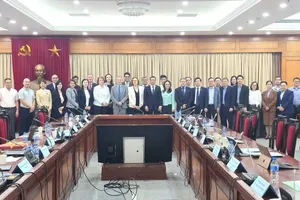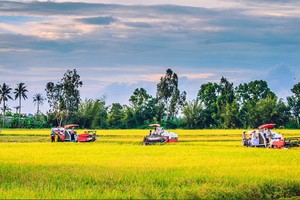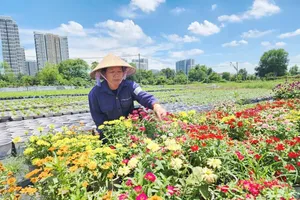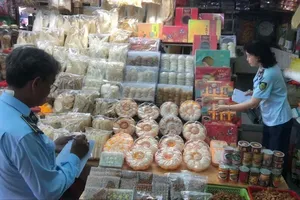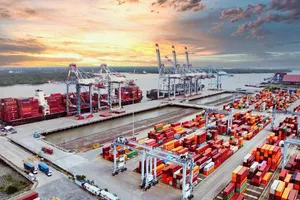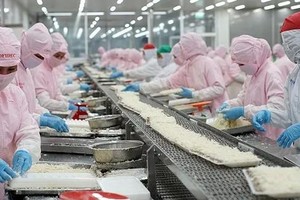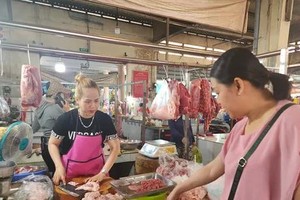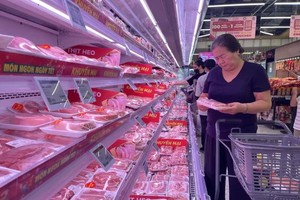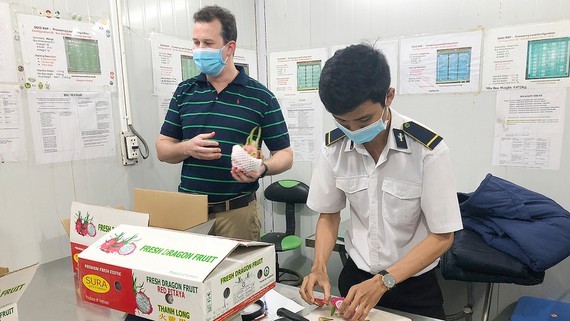
Developing new supply chains
According to the Vietnam Farms and Agricultural Enterprises Association, last year, Vietnam signed many important economic agreements. Noticeably, the RCEP signed in last November is considered the largest agreement in the world, with a scale of about 2.2 billion consumers, accounting for about 30 percent of global gross domestic product (GDP), at about US$26 trillion.
“The RCEP is expected to bring Vietnam's agricultural sector into a new stage by creating the largest free trade area in the world, with the development of regional and global value chains, increasing the prospects of attracting domestic and foreign investment. With the RCEP, it will help enterprises to overcome difficulties, access new markets, and restore production better, opening up export opportunities,” said Mr. Le Minh Duy, Chairman of the Vietnam Farms and Agricultural Enterprises Association. He added that the RCEP also standardized the rules related to trade competition, anti-dumping, and anti-subsidy taxes.
The RCEP includes 10 ASEAN member countries and five countries, including Australia, China, South Korea, Japan, and New Zealand. Mr. Dang Phuc Nguyen, General Secretary of the Vietnam Fruit and Vegetable Association, said that the RCEP is larger than the trade bloc of the US, Mexico, and Canada, as well as the European Union. Because, the GDP of the RCEP members surpasses the GDP of member countries of the Comprehensive and Progressive Agreement for Trans-Pacific Partnership (CPTPP), due to the presence of China.
According to the economic development process, RCEP members are expected to exceed $100 trillion by 2050. The RCEP will create opportunities to develop new supply chains and export more items. For instance, the Chinese market only allows 10 items of fresh fruit and vegetables for official export. Now thanks to the RCEP, the export of other products, such as durian, passion fruit, avocado, pomelo, and star apple, can be expanded.
Similarly, the opening of more new products for the markets of Japan, South Korea, Thailand, and New Zealand, will be more favorable. Most of the countries participating in this agreement have the demand to import Vietnam's main products, such as agricultural and aquatic products. The import standards and consumer tastes are quite similar among these countries. The geographical distances of the intra-regional countries are not too far, so logistics costs are lower, and the transport of goods to these countries is easier than to other markets, like the US and Europe.
The tendency of selecting tropical agricultural products
According to the Ministry of Agriculture and Rural Development, on average, South Korea imports about $35 billion of agricultural, forestry, and aquatic products each year, but Vietnamese products merely account for a very small proportion of them. For instance, the export value of Vietnamese vegetables and fruits to the Korean market in 2019 reached $131 million, accounting for only 3.5 percent of the market share, although it increased by 15.7 percent over the same period in 2018. Similarly, Japan is the fourth-largest import market for agricultural products in the world, but Vietnamese products account for a very small proportion. If Vietnamese products meet the tastes and quality well, there is still room for growth in the Korean and Japanese markets, especially for processed products.
Similarly, many countries participating in the RCEP are also increasing the import of tropical fresh fruits. Export growth of fruits and vegetables has been fairly high over the past years, especially tropical fruits, which account for a large proportion. This is a great opportunity for the fruit industry of Vietnam, which has a wide variety of tropical fruits. It poses a challenge for the export of Vietnamese fruits when the fruit storage and preliminary processing capacity of the country remain relatively low.
Amid the context of the Covid-19 pandemic, fresh products are increasingly sold through the online platform. However, many enterprises do not understand the procedures, regulations on quality, packaging, and labels, leading to violations, causing the goods to be returned, adding many costs. Mr. Dang Phuc Nguyen shared that many enterprises have not fully mastered the implementation of e-commerce, which relies on some technologies, such as electronic funds transfer, supply chain management, internet marketing, online transactions, electronic data interchange, inventory management systems, and automated data collection systems. Besides, the VietGAP and GlobalGAP production areas are still modest, only accounting for 10-15 percent, making it difficult to mobilize a large volume of products that meet export standards.
Mr. Nguyen Dinh Tung, CEO of Vina T&T Company, shared that trade agreements help the agricultural sector to produce safe products following international standards. Enterprises with good development backgrounds, high-quality products that meet market requirements have better competitive opportunities. On the other hand, in the domestic market, domestic enterprises must also increase the quality of their products to compete with imported ones. Therefore, the State needs to create many bridges between farmers and enterprises, help farmers and enterprises to approach the right direction, taking the market as the target and the market standards as a measure of quality.
At the same time, the State needs to build quality standards for agricultural products suitable for developed markets, like the US; thereby, controlling the quality and branding, and increasing the value of Vietnamese agricultural products. Market research and trade promotion need to be strengthened and diversified the participants with the association of the State, associations, and localities to create an environment for people to learn and exchange experiences.
According to the Vietnam Farms and Agricultural Enterprises Association, last year, Vietnam signed many important economic agreements. Noticeably, the RCEP signed in last November is considered the largest agreement in the world, with a scale of about 2.2 billion consumers, accounting for about 30 percent of global gross domestic product (GDP), at about US$26 trillion.
“The RCEP is expected to bring Vietnam's agricultural sector into a new stage by creating the largest free trade area in the world, with the development of regional and global value chains, increasing the prospects of attracting domestic and foreign investment. With the RCEP, it will help enterprises to overcome difficulties, access new markets, and restore production better, opening up export opportunities,” said Mr. Le Minh Duy, Chairman of the Vietnam Farms and Agricultural Enterprises Association. He added that the RCEP also standardized the rules related to trade competition, anti-dumping, and anti-subsidy taxes.
The RCEP includes 10 ASEAN member countries and five countries, including Australia, China, South Korea, Japan, and New Zealand. Mr. Dang Phuc Nguyen, General Secretary of the Vietnam Fruit and Vegetable Association, said that the RCEP is larger than the trade bloc of the US, Mexico, and Canada, as well as the European Union. Because, the GDP of the RCEP members surpasses the GDP of member countries of the Comprehensive and Progressive Agreement for Trans-Pacific Partnership (CPTPP), due to the presence of China.
According to the economic development process, RCEP members are expected to exceed $100 trillion by 2050. The RCEP will create opportunities to develop new supply chains and export more items. For instance, the Chinese market only allows 10 items of fresh fruit and vegetables for official export. Now thanks to the RCEP, the export of other products, such as durian, passion fruit, avocado, pomelo, and star apple, can be expanded.
Similarly, the opening of more new products for the markets of Japan, South Korea, Thailand, and New Zealand, will be more favorable. Most of the countries participating in this agreement have the demand to import Vietnam's main products, such as agricultural and aquatic products. The import standards and consumer tastes are quite similar among these countries. The geographical distances of the intra-regional countries are not too far, so logistics costs are lower, and the transport of goods to these countries is easier than to other markets, like the US and Europe.
The tendency of selecting tropical agricultural products
According to the Ministry of Agriculture and Rural Development, on average, South Korea imports about $35 billion of agricultural, forestry, and aquatic products each year, but Vietnamese products merely account for a very small proportion of them. For instance, the export value of Vietnamese vegetables and fruits to the Korean market in 2019 reached $131 million, accounting for only 3.5 percent of the market share, although it increased by 15.7 percent over the same period in 2018. Similarly, Japan is the fourth-largest import market for agricultural products in the world, but Vietnamese products account for a very small proportion. If Vietnamese products meet the tastes and quality well, there is still room for growth in the Korean and Japanese markets, especially for processed products.
Similarly, many countries participating in the RCEP are also increasing the import of tropical fresh fruits. Export growth of fruits and vegetables has been fairly high over the past years, especially tropical fruits, which account for a large proportion. This is a great opportunity for the fruit industry of Vietnam, which has a wide variety of tropical fruits. It poses a challenge for the export of Vietnamese fruits when the fruit storage and preliminary processing capacity of the country remain relatively low.
Amid the context of the Covid-19 pandemic, fresh products are increasingly sold through the online platform. However, many enterprises do not understand the procedures, regulations on quality, packaging, and labels, leading to violations, causing the goods to be returned, adding many costs. Mr. Dang Phuc Nguyen shared that many enterprises have not fully mastered the implementation of e-commerce, which relies on some technologies, such as electronic funds transfer, supply chain management, internet marketing, online transactions, electronic data interchange, inventory management systems, and automated data collection systems. Besides, the VietGAP and GlobalGAP production areas are still modest, only accounting for 10-15 percent, making it difficult to mobilize a large volume of products that meet export standards.
Mr. Nguyen Dinh Tung, CEO of Vina T&T Company, shared that trade agreements help the agricultural sector to produce safe products following international standards. Enterprises with good development backgrounds, high-quality products that meet market requirements have better competitive opportunities. On the other hand, in the domestic market, domestic enterprises must also increase the quality of their products to compete with imported ones. Therefore, the State needs to create many bridges between farmers and enterprises, help farmers and enterprises to approach the right direction, taking the market as the target and the market standards as a measure of quality.
At the same time, the State needs to build quality standards for agricultural products suitable for developed markets, like the US; thereby, controlling the quality and branding, and increasing the value of Vietnamese agricultural products. Market research and trade promotion need to be strengthened and diversified the participants with the association of the State, associations, and localities to create an environment for people to learn and exchange experiences.
